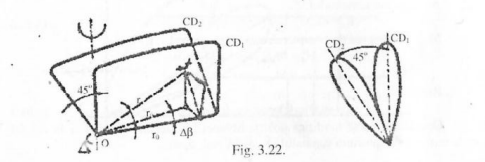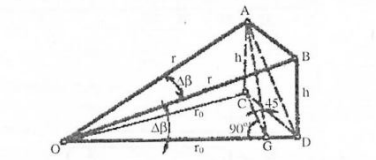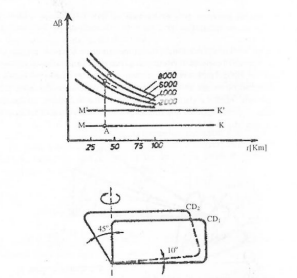At the discovery radiolocation stations, a system of antennas can be built, which will achieve two characteristics of narrow directivity in the horizontal plane and wide in the vertical plane. One of the characteristics of directivity is vertical, and the second is inclined by 45°.

The determination of the distance and the azimuth is made with the help of the vertical characteristic, the display of the cooordonates and their reading being made on a circular observation indicator.
If the height of the target is determined, both antennas are used, which rotate at constant speed. This causes the target to be observed first with the characteristic of vertical directivity and then the inclined one. Between the two observations, the antenna system will rotate with an angle Δβ. By measuring this angle and measuring the distance to the target, the height of the target can be determined.

OA=OB=D- the distance inclined to the target measured with the two characteristics of directivity.
OC=OD=Do-horizontal distance
ΔODB- it is found in the vertical feature
ΔODA- is found in the inclined feature
ΔGCA-it is isosceles because ∠CGA=∠CAG=45°
CG=CA=h
From the right triangle OCG it results
h=Do·sinΔβ
From ΔODB results
Do=√(D2-h2)
Where the hight comes from
h=DsinΔβ⁄ √(1+sin2Δβ)
For the direct reading of the height, a special indicator is used on which will be successively displayed the signals of the received target on the two characteristics of directivity. On the indicator are drawn the constant height curves according to the above relation.

The V-type antenna can be horizontal or sloping. The maximum radiating power corresponds to the bisector of the narrow angle of the antenna. In the opposite direction the radiating power is minimal. For radio stations R-140, R-161, the V-inclined antenna – V2x46 is used, with a radius length of 46 m. located at an angle of ~50°.
The ends of the rays are connected to a load of R = 400 Ohm, 240 Wt and counterweight. The counterweight wires are directed in the direction of radiation of the antenna (towards the correspondent). The working frequency of the antenna is between 10 ÷ 30 Mhz. The antenna is designed to provide long-distance connection.